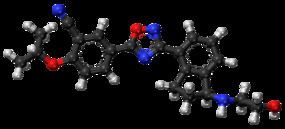ATC code None Biological half-life 19 hours CAS Number 1306760-87-1 Molar mass 404.46 g/mol | Legal status Investigational Synonyms RPC1063 PubChem CID 52938427 ChemSpider ID 34979946 | |
 | ||
Ozanimod (RPC-1063) is an investigational immunomodulatory drug currently in phase III clinical trials for the therapy of relapsing multiple sclerosis (RMS) and ulcerative colitis (UC). It acts as a sphingosine-1-phosphate (S1P) receptor agonist, sequestering lymphocytes to peripheral lymphoid organs and away from their sites of chronic inflammation. Shortly after Receptos, Inc. developed ozanimod, they were acquired by Celgene for $7.2 billion.
Contents
Pharmacodynamics
Ozanimod is an agonist of the S1P1 and S1P5 receptors. It demonstrates this effect in a dose-dependent manner, with 10-fold potency to three comparators. This is an improvement of selectivity over its predecessor, fingolimod, which is non-specific to all 5 isotypes. The agonism of S1P directly causes its internalization and degradation through the ubiquitin-proteosome pathway. The loss of S1P leads to a decrease in the total lymphocyte count in circulation, specifically CD4+ CCR7+ and CD8+ CCR7+ T cells.
Pharmacokinetics
Ozanimod has a high oral bioavailability, a circulating half-life of about 19 hours, and reaches highest blood plasma concentrations after about 6 hours. Ozanimod is dehydrogenated by two CYP enzymes into two active metabolites, all with similar pharmacokinetics. The decrease in lymphocyte count lasts for approximately 14 days after treatment discontinuation. Unlike fingolimod, it does not require phosphorylation for activation, nor does it demonstrate cardiac abnormalities or hepatotoxicity.
Touchstone
Touchstone is a double-blind, placebo controlled phase II clinical for the treatment of ulcerative colitis. (NCT01647516). 197 patients, ages 18–75, with moderate to severe UC (Mayo Score 6-10) were recruited and assigned either placebo, 0.5 mg or 1 mg of oral ozanimod followed by 1 week of dose escalation. The 1 mg dose showed a slight increase in rate of clinical remission of UC and total lymphocyte decrease as compared to the placebo, with the most common adverse effects being headaches and anemia. The authors noted that limitations on this study included a brief duration and small sample size, meaning they could not assess safety nor efficacy.
Radiance
Radiance is a double-blind, placebo controlled phase combined II/III clinical trial for the treatment of relapsing multiple sclerosis (NCT01628393). For the phase II trial, 258 patients, ages 18–55 with RMS (Mean Expanded Disability Status Scale of 2.9) were assigned either placebo, 0.5 mg or 1 mg of oral ozanimod followed by 1 week of dose escalation. Ozanimod significantly reduced MRI lesion activity in participants with relapsing multiple sclerosis over a period of 24 weeks. Both doses of ozanimod reached anticipated range of 60-70% decreased lymphocyte count, and were well tolerated, with a safety profile consistent with a previous phase 1 study in healthy volunteers. The most common adverse effects as compared to the placebo were: nasopharyngitis, headache, and urinary-tract infections, with no serious infectious or cardiac adverse effects. With these results, both doses of ozanimod were taken forward into the 2-year long phase III trial and is completed but unpublished as of November 2016.
Sunbeam
Sunbeam is the second RMS phase III clinical trial to establish the dose with optimum safety-benefit relationship, with an estimated size of 1200 patients (NCT02294058). It began in November 2014 and has an estimated completion date of February 2017.
Commercial
After going public in May 2013, Receptos, Inc. stock surged with the clinical data ozanimod displayed as a first in class S1P immunomodulating drug. In August 2015, Receptos was acquired by Celgene for $7.2 billion through a combination of cash in hand and new debt, leading to a 22% increase in their stock value. Receptos, Inc. (Celgene) patented the synthesis of ozanimod in July 2016. With the expansion of Celgene's inflammation and immunology profile, the company is expecting to generate $4 to $6 billion in annual sales from ozanimod, with plans to file for regulatory approval in 2018.
